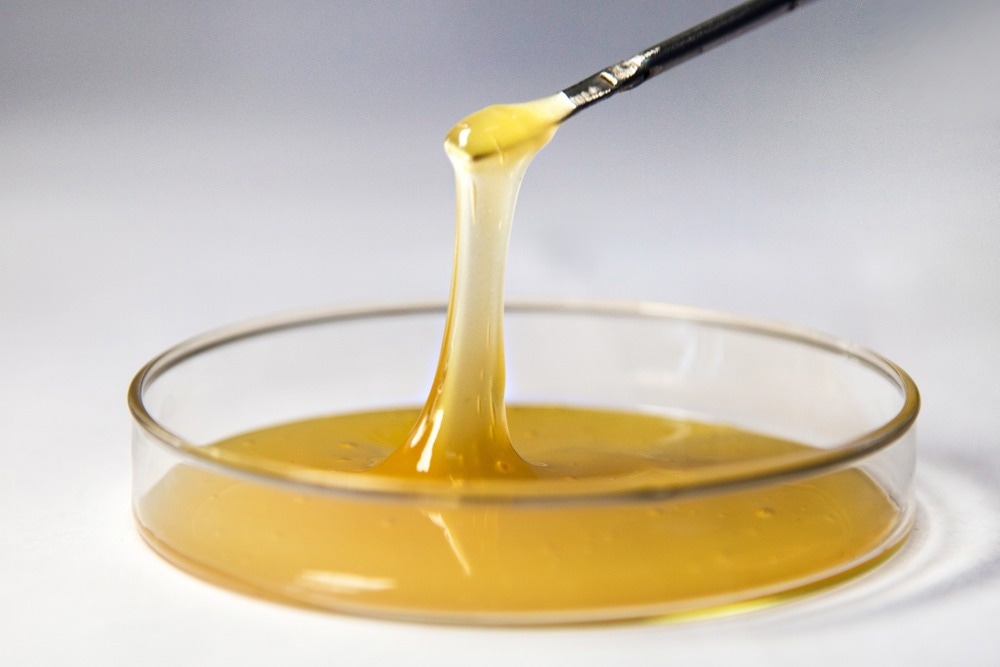Updated by Reginald Davey 03/03/2023
A number of factors can influence viscosity in gases and liquids, which is an important consideration for material design. This article will discuss the effect of changing temperature on the viscosity of liquids and gases.

Image Credit: Akim Lakeev/Shutterstock.com
Introduction
With an increase in temperature in a fluid, there is typically an increase in the molecular interchange as molecules move faster in higher temperatures. Viscosity typically decreases as temperature increases. Generally speaking, a fluid’s viscosity is related to how easily molecules can move in respect to one another.
Do Gases Have Viscosity?
The viscosity of gas increases with temperature. According to the kinetic theory of gases, viscosity should be proportional to the square root of the absolute temperature. In practice, it increases more rapidly.
Viscosity and Temperature in Liquids
Different liquids have different viscosities. For example, the viscosity of honey is much higher than that of water. Amongst fluids, gases have lower viscosities than liquids. Viscosity is measured using a viscometer.
In a liquid, there will be molecular interchange similar to those developed in a gas but also additional, substantial, attractive, cohesive forces between the molecules within a liquid (which are much closer together than those of a gas). Both cohesion and molecular interchange contribute to liquid viscosity.
The impact of increasing the temperature of a liquid is to reduce the cohesive forces while simultaneously increasing the rate of molecular interchange.
The former effect causes a decrease in the shear stress, while the latter causes it to increase. The result is that liquids show a reduction in viscosity with increasing temperature. With high temperatures, viscosity increases in gases and decreases in liquids; the drag force will do the same.
Impact of Increasing Temperature
The impact of increasing temperature is to slow down the sphere in gases and accelerate it in liquids. Considering a liquid at room temperature, the molecules are tightly bound together by attractive inter-molecular forces such as Van der Waal forces.
It is these attractive forces that are responsible for the viscosity since it is difficult for individual molecules to move due to being tightly bound to their neighbors.
The increase in temperature causes the kinetic or thermal energy to increase and the molecules become more mobile.
The attractive binding energy is reduced, and therefore the viscosity is reduced. If the liquid continues to be heated, the kinetic energy will exceed the binding energy and molecules will escape from the liquid and it can become a vapor.
Viscosity of Water at Different Temperatures
Water is the most abundant liquid on Earth and is used in multiple industrial and commercial processes. Knowledge of the viscosity of water at different temperatures is vital for the design of products and industrial machinery.
Water, being the most abundant and studied of all liquids, is a good starting place when learning about viscosity and how factors such as temperature can affect a fluid. At room temperature, water has a dynamic velocity of approximately 1.0 mPa/s. At around 375oC, this decreases to under 0.1 mPa/s.
Commercial Importance of Viscosity
Viscosity in a liquid or gas is a key parameter in the design of products as it is an important quality indicator for consumers. For instance, a thicker liquid may be thought of as superior in quality to a thinner one.
In the food industry, viscosity measurements are an integral part of the production process to maximize cost-effectiveness and efficiency. In construction, the viscosity of concrete governs its pumping and self-leveling behavior. Viscosity is also vital for cosmetics design as it influences the flow and feel of products.
Viscosity is integral to the design of lubricants for many industries such as the automotive industry. Engine oils and lubricants must be able to function properly over a wide range of temperatures, from sub-zero conditions in winter to the hot summer months to ensure optimal performance in automobiles.
Proper knowledge of how temperature influences the viscosity of gases and liquids is essential for ensuring the optimal design of commercial and industrial products, from petroleum and refined industrial chemicals to a multitude of domestic consumer goods.
In Summary
Temperature influences the viscosity of liquids and gases, which is a key parameter in the design of many products such as oils, lubricants, food, and cosmetics. Increasing molecular interchange decreases the viscosity of a fluid as temperature increases and vice versa as temperature decreases.
To ensure the optimal design of liquid and gaseous products with the highest performance possible over a range of temperatures, it is essential to understand the influence of temperature on this key material parameter.
More from AZoM: Assessing the Cooked Viscosity of Ground Materials

This information has been sourced, reviewed and adapted from materials provided by Fungilab.
For more information on this source, please visit Fungilab.